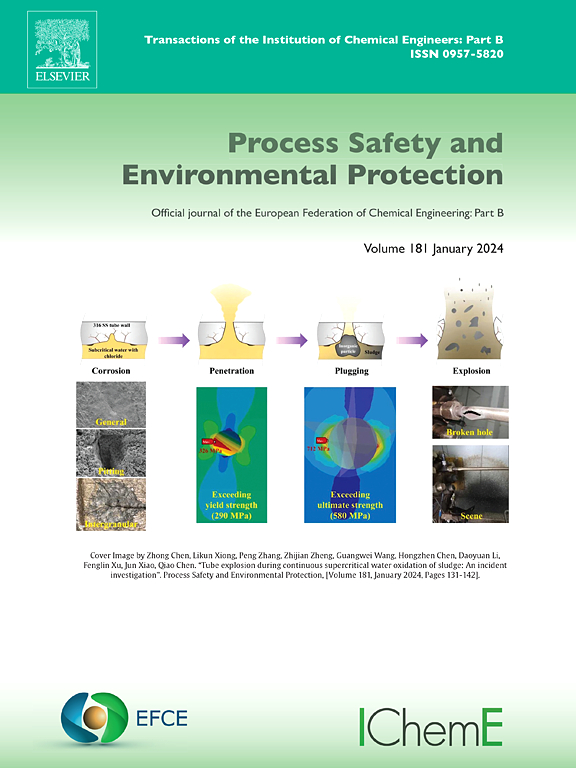超临界流体法处理酸樱桃加工废水:序贯回收与处理
IF 6.9
2区 环境科学与生态学
Q1 ENGINEERING, CHEMICAL
引用次数: 0
摘要
水果加工工业废水中含有大量的生物活性物质。在可持续性框架和循环经济中,副产品可以在处理之前转化为宝贵的资源。通过整合管理策略,该行业可以最大限度地减少其环境足迹,提高经济效益,并支持淡水资源的可持续性。本研究采用超临界流体法连续回收(超临界CO2: SC-CO2)和处理(超临界水氧化:SCWO)。在这项研究中,酸樱桃UF保留与高负荷有机物,其中包括特别有价值的酚类。测定COD平均值为15650 mg/L,总酚物质含量(TPC)为457 mg /L。采用SC-CO2萃取法,提取液中TPC和总黄酮含量的回收率分别可达5 %和10 %。此外,测定的最高富集效率为35 %和140 %。酸樱桃UF保留液的TPC为72 mg/100 g样品,而在40 °C和30 MPa条件下,提取液的TPC高达278 mg/100 g。与其他酚类物质相比,酚类物质中的黄酮类化合物在SC-CO2中具有较高的回收率。萃取后,用超临界水氧化法处理样品。高有机负荷废水在短时间内(15 min)得到有效处理,去除率在78 % ~ 98 %之间变化。此外,在选定的最佳提取(27 MPa和40 °C)和氧化(1.68 DOD和3 min)条件下进行了毒性试验,提取和处理后的废水的毒性单位与从原液中获得的水蚤和费氏弧菌毒性试验相比有所降低。研究结果表明,超临界流体法是处理果汁工业废水的一种较好的方法。本文章由计算机程序翻译,如有差异,请以英文原文为准。
Management of sour cherry processing industry wastewater by super critical fluid method: Sequential recovery and treatment
The fruit processing industry wastewater contains a significant amount of bioactive substances. In the sustainability framework and the circular economy, the by-product can be transformed into valuable resources before being treated. By integrating management strategies, the industry can minimize its environmental footprint, promote economic benefits, and support the sustainability of freshwater resources. This study subjected consecutively recovery (supercritical CO2: SC-CO2) and treatment (supercritical water oxidation: SCWO) by using the supercritical fluid method. In this study, sour cherry UF retentate with high-load organics, which include especially valuable phenolics was used. The mean COD and total phenolic substance content (TPC) were determined as 15,650 mg/L and 457 mg GAE/L, respectively. Recovery efficiencies of TPC and total flavonoid substance content (TFC) of extracts were up to 5 % and 10 % with SC-CO2 extraction, respectively. Additionally, the highest enrichment efficiencies were determined as 35 % and 140 %. While the TPC of sour cherry UF retentate was 72 mg/100 g sample, it increased up to 278 mg/100 g in the extract obtained under 40 °C and 30 MPa. Flavonoids from phenolic substances had high recoverability in SC-CO2 compared to the other phenolic groups. Following extraction, the samples were treated using the supercritical water oxidation process. Wastewater with high organic load was effectively treated in a short time (15 min) and the removal efficiencies changed between 78 % and 98 %. Additionally, toxicity tests were conducted in selected optimum extraction (27 MPa and 40 °C) and oxidation (1.68 DOD and 3 min) conditions, and the toxicity units of extracted and treated wastewaters decreased compared to those obtained from raw wastewater for Daphnia magna and Vibrio fischeri toxicity tests. These findings show that the supercritical fluid method can be a favorable alternative for management of fruit juice industry wastewater.
求助全文
通过发布文献求助,成功后即可免费获取论文全文。
去求助
来源期刊

Process Safety and Environmental Protection
环境科学-工程:化工
CiteScore
11.40
自引率
15.40%
发文量
929
审稿时长
8.0 months
期刊介绍:
The Process Safety and Environmental Protection (PSEP) journal is a leading international publication that focuses on the publication of high-quality, original research papers in the field of engineering, specifically those related to the safety of industrial processes and environmental protection. The journal encourages submissions that present new developments in safety and environmental aspects, particularly those that show how research findings can be applied in process engineering design and practice.
PSEP is particularly interested in research that brings fresh perspectives to established engineering principles, identifies unsolved problems, or suggests directions for future research. The journal also values contributions that push the boundaries of traditional engineering and welcomes multidisciplinary papers.
PSEP's articles are abstracted and indexed by a range of databases and services, which helps to ensure that the journal's research is accessible and recognized in the academic and professional communities. These databases include ANTE, Chemical Abstracts, Chemical Hazards in Industry, Current Contents, Elsevier Engineering Information database, Pascal Francis, Web of Science, Scopus, Engineering Information Database EnCompass LIT (Elsevier), and INSPEC. This wide coverage facilitates the dissemination of the journal's content to a global audience interested in process safety and environmental engineering.
 求助内容:
求助内容: 应助结果提醒方式:
应助结果提醒方式:


